
Statue of Marshal Bagramyan in Yerevan, standing in front of the American University of Armenia and next to the British embassy.
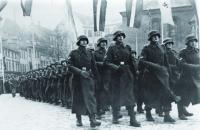
15th SS Division December 1943.
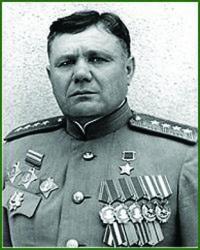
Andrei Ivanovich Eremenko, wearing star of Hero of the Soviet Union, commander Second Baltic Front.

Soviet propaganda poster celebrating the liberation of the Baltic States.
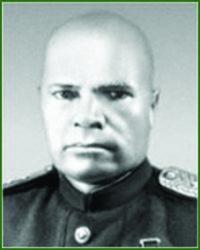
Ivan Maslennikov, commander, Third Baltic Front.
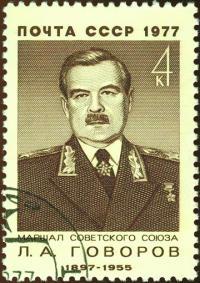
Marshal Leonid Govorov, commander Leningrad Front, with Hero of the Soviet Union star.
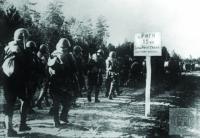
Soviet troops moving towards Riga.
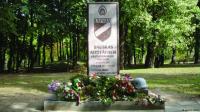
Monument to SS Latvian soldiers.
THIS WEEK, seventy years ago, the Red Army recaptured the750 year-old city of Riga, which is, and was, the capital, and largest city, of Latvia. Today, the city has a population of 700,000, which is more than one-third of Latvia’s population, and it is almost evenly divided between Russians and Latvians. The city is located on the Gulf of Riga, at the mouth of the Daugava River.
Latvia had only been an independent country since the end of WWI, in 1918. Prior to that, it had been, from 1611, a part of, first the Kingdom of Sweden, and then, beginning in 1710, it was incorporated, in three stages over 85 years, into the Russian Empire. While a part of the Swedish Kingdom, Riga was the largest city in Sweden and was the largest port in the Russian Empire.
On October 5, 1939, Latvia, with the Red Army at its borders, and the German Wehrmacht and the Red Army having just divided Poland between them, executed an agreement with the U.S.S.R., allowing the Soviets to station troops within Latvian borders. Similar agreements were reached with the two other Baltic countries of Lithuania and Estonia. Knowing what lay ahead for Latvia, Hitler arranged for the repatriation of all ethnic Germans from Latvia and the other Baltic countries. By early 1940, 51,000 had been relocated from Latvia to the German Reich. Most were resettled in areas recently incorporated into the Reich from Poland, and given homes that had been “vacated” by their Polish owners.
On March 25, 1940, Soviet Foreign Minister Vyacheslav Molotov observed that, “...the execution of the pacts progressed satisfactorily and created conditions favorable for a further improvement of the relations between the Soviet Union and these States.”
In June 1940, Molotov accused the Baltic states of conspiring against the Soviet Union. As the world’s attention was focused on the fall of France and the sound of German jackboots goose-stepping down the Avenue des Champs-Élysées, in the French capital, hundreds of thousands of Soviet troops occupied the three countries, in, “...a further improvement of the relations between the Soviet Union and these States.” Elections were held on July 14, with the results announced, in Moscow, twelve hours before the polls closed!
On July 21, 1940, the Estonian, Lithuanian and Latvian, Soviet Socialist Republics were formed and “requested” admission into the U.S.S.R. - which was granted, forthwith. They became the 12th, 13th and 14th members, respectively, of the Union of Soviet Socialist Republics, during the first week of August 1940. Immediately, young men were conscripted into the Red Army, skilled workers were taken to work in Russian factories and the educated were shipped to gulags in Siberia. During the first year of the “dictatorship of the proletariat,” in Latvia, 35,000 Latvians were relocated - one way or the other.
Elements of Army Group North, commanded by Field Marshal Baron Wilhelm von Leeb, entered the Latvian capital of Riga, on July 1, 1941. Latvians who had been conscripted into the Red Army deserted in droves, with many turning on their erstwhile comrades and capturing various Latvian villages, ahead of the Germans. By July 10, the entire country was occupied by the Germans.
The Siege of Leningrad was lifted on January 27, 1944. From that point, the Leningrad Front, commanded by Marshal Leonid Govorov steadily drove Army Group North back toward Germany. On February 2, 1944, Marshal Govorov’s Leningrad Front assaulted Axis troops on the Narva River, in Estonia.
The Red Army launched Operation Bagration on June 22, 1944, against Army Group Center, which was utterly destroyed. Subsequently, First, Second and Third Baltic Fronts, commanded by Ivan Bagramyan, Andrei Yeremenko and Ivan Maslennikov swung to their right and headed for the Baltic coast. General Bagramyan’s Front reached the 700-year-old town of Tukums on the west side of the Bay of Riga on July 30, earning the General his first Hero of the Soviet Union star. On September 14, 1944, the three fronts launched an offensive against Army Group North. But the Army Group, now commanded by Colonel-General Ferdinand Schörner, held. Riga was defended by II, L and Sixth SS Corps, commanded by Wilhelm Hasse, Hans Boeckh-Behrens, and Walther Krüger. Generals Hasse and Boeckh-Behrens would die in Soviet captivity. SS-Obergruppenführer Krüger committed suicide, in May 1945, after the surrender. These three corps were a part of 16th Army, commanded by Carl Hilpert.
Obergruppenfürher Krüger’s SS Korps was composed of the 1st and 2nd SS Latvian divisions, commanded by Herbert von Obwurzer and Bruno Streckenbach. Thus the two divisions of Latvian soldiers were now defending their nation’s capital against the Red Army’s onslaught.
Meanwhile, Marshal Govorov’s Leningrad Front had broken the German line along the Narva River and was sweeping through Estonia.
By October 10, 51st Army, commanded by Yakov Grigorevich Kreizer, had recaptured the 800-year-old town of Polangen on the Lithuanian coast of the Baltic Sea, isolating General Schörner’s Army Group North, renamed Army Group Courland. General Schörner determined to withdraw from Riga, after obtaining der Fürher’s permission, in order to shorten the Army Group’s lines and make its position more defensible. On October 13, units of General Maslennikov’s Third Baltic Front entered the Latvian capital. Subsequently, this Front was eliminated, by the Soviet high command, and its armies dispersed amongst other fronts.
By the Wehrmacht’s withdrawal, the Red Army was denied the opportunity, and excuse, to turn the Latvian capital into another Stalingrad.
NEXT WEEK: METZ
Mr. Wimbrow writes from Ocean City, Maryland, where he practices law representing those persons accused of criminal and traffic offenses, and those persons who have suffered a personal injury through no fault of their own.
«Go back to the previous page.







